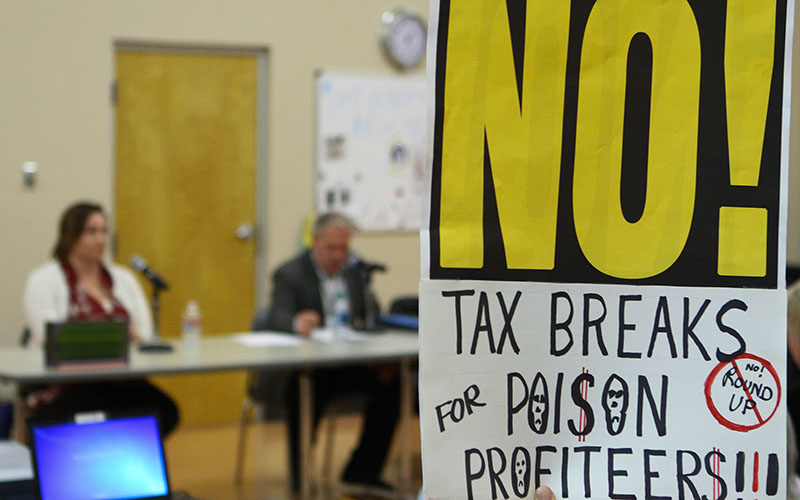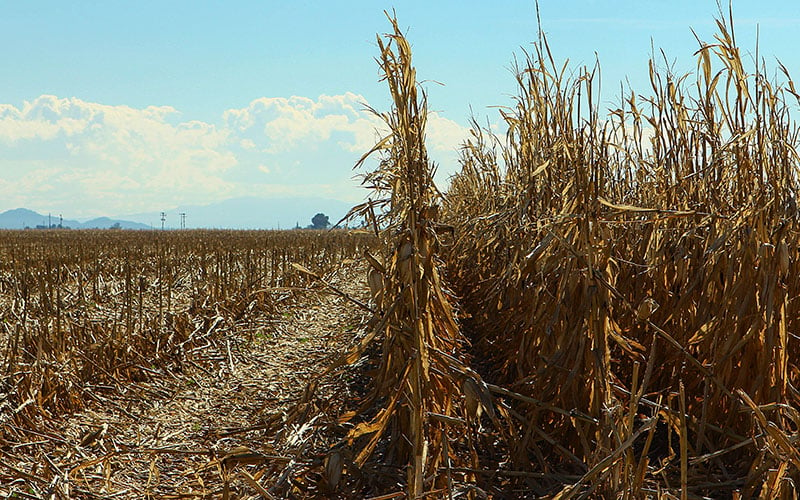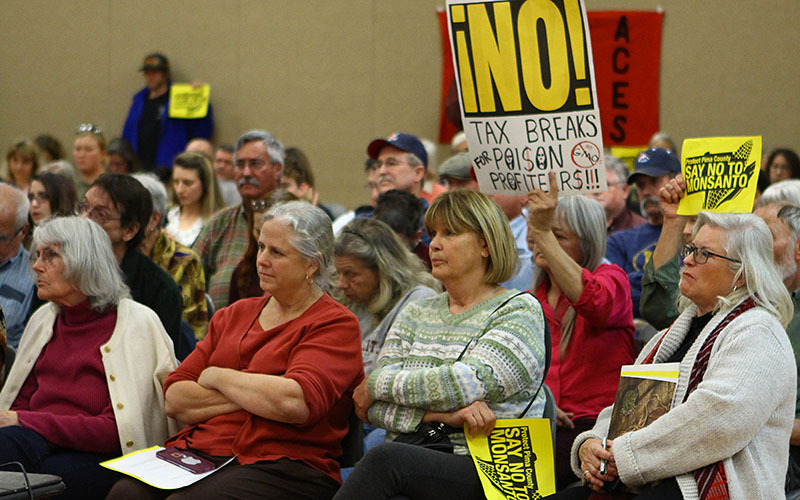
Most of about 50 Tucson-area residents at a Pima County meeting in January opposed a move by Monsanto to grow GMO corn in a seven-acre greenhouse in Marana. (Photo by Taryn Martin/Cronkite News)
TUCSON – Tucson-area residents who oppose a Fortune 500 company’s plans to grow genetically modified crops at a new greenhouse in Marana won a partial victory.
The greenhouse will still be built but Monsanto is withdrawing its request for an incentive to cut property taxes by receiving Foreign Trade Zone status, according to a letter submitted to the Pima County Board of Supervisors. The board had been poised to vote on Monsanto’s withdrawal on Tuesday.
“I am happy that the taxpayers are not going to be subsidizing them, but I am sad that they are continuing to expand and grow,” said Tucson resident Sandra Almasy.
The withdrawal still means the corporation can build the seven-acre greenhouse on 155 acres it owns in Marana, near Tucson.

Two corn headers sit in a half-harvested field in Marana, south of Interstate-10. (Photo by Taryn Martin/Cronkite News)
Monsanto withdrew the Foreign Trade Zone proposal “to make those investments possible,” according to an emailed statement Tuesday. The company pledged to donate up to $500,000 to a local school foundation.
Residents had fought the tax-break status for weeks.
Sign-carrying protesters packed a hearing room one evening in January in continuing moves to try to stop the plan, despite little ability to do so. One man rapped his opposition, ending with others shouting “no, no, no to Monsanto.”
One woman wore a medical mask. Almasy wielded a sign, “no tax break for poison profiteers,” referring to proposed tax incentives for Monsanto, an agricultural corporation that would grow genetically modified corn in the greenhouse.
McClerren, who attended the meeting to discuss the project and respond to public comment, tried to calm the crowd of about 100 people through a slideshow presentation, which outlined the plans for the project and how Monsanto has adapted into a company focused on seeds and trade.
Only one person, a farmer who said he was neutral in the greenhouse controversy, spoke in favor of GMOs.
The hearing was among five conducted over several weeks in Pima County, meant to answer community concerns about genetically modified organisms, known as GMOs.

Pima County residents silently protested at a public meeting about a planned Monsanto greenhouse nearTucson. (Photo by Taryn Martin/Cronkite News)
Changing the genetic makeup of crops has become a hot-button issue across the country in recent years, with food producers marketing food like canned beans as ‘non-GMO” and the farm-to-table movement gaining popularity.
The science on whether gene modification is dangerous or benign is limited, but the white-hot response in Marana shows a continuing controversy over altering food genetics in a culture where natural foods are gaining ground.
Angst over a tax break
Monsanto was asking the supervisors to grant them Foreign-Trade Zone status, which would have reduced the company’s property taxes.
“That is something that is a pretty standard business practice for most businesses when they go in and make an investment, like the type of investment we are making in this community,” McClerren said in an interview after the meeting.
Pima County had the power to veto the tax break incentive, and deliberated over approval since Monsanto purchased land in Marana in October.

A half-harvested field of corn on a sunny day in Marana, south of Interstate-10. (Photo by Taryn Martin/Cronkite News)
Monsanto plans to invest between $95 million and $100 million into the project. If the company had been approved, the property assessment tax would have dropped from 15 percent as a qualified agricultural property, to five percent.
Opponents had asked the county to turn down the tax break, essentially making it more financially difficult for Monsanto to build in Tucson. The company plans to begin construction of the greenhouse later this year and finish in 2018.
Monsanto plans to continue its partnership with the county, and plans to donate up to $500,000 to the Marana Unified School District Foundation, company representatives said.
Controversial accusations
Community members have claimed, in meetings and written documents, that GMOs will inject toxins into the soil, and have asked for a community task force to review whether there are risks to Monsanto’s intended land use.
“We definitely need at least a citizen’s task force that will weigh the image problems, as well as the potential risk from toxins, in a region just designated an international treasure for its native agriculture,” Tucson resident Linda Griffith said in comments posted on pima.gov.
Other written comments also raised concerns over the county facilitating a tax break and allowing a company they believe causes pollution to operate in southern Arizona.

Patrick Cavanaugh, deputy director for Pima County economic development, listens to public concerns about a proposed Monsanto greenhouse at a public meeting in Marana. (Photo by Taryn Martin/Cronkite News)
Community members have also expressed concern over the use of Roundup, a pesticide produced by Monsanto that is used on their crops to kill weeds, and have questioned the safety of the chemicals in the product.
“I am philosophically opposed to Monsanto’s business model of developing pesticide- and herbicide-resistant plants and do not believe that the county is prepared to deal with toxic drift, super weed release, ecological damage or effluent management,” wrote Tucson resident Melin Canez.
Monsanto spokeswoman Charla Lord responded: “From her statement, it sounds like she believes this to be open-field agriculture.” Lord, in an email, states Pima County farmers have grown genetically modified crops for years, including alfalfa, cotton, and corn.

Pima County residents listened at an information session in Tucson about a planned Monsanto greenhouse on seven acres in nearby Marana. (Photo by Taryn Martin/Cronkite News)
The land for the greenhouse has already been purchased and plans for the project are already underway, so there is little opponents can do to stop the project.
“All they can do now is not give them a tax break,” Almasy said after the meeting.
Local farmer Arnold Burruel, said at the hearing he neither supports nor opposes the Monsanto greenhouse, but believes that using pesticides on crops is safe and effective.
“I am the guy that raised his children on the edge of those fields, and I have seen those pesticide applications go from 12 to 17 per season, to one, this year, none, on 2,200 acres of cotton – I did not spray once,” Burruel said.
Building a Greenhouse in Pima County
Monsanto plans to build the greenhouse on the land they purchased in Marana, at Sanders and Twin Peaks roads.
“The greenhouse is going to allow us to deliver better products faster, and it is going to allow us to improve the sustainability of our own operations,” McClerren said in an interview after the meeting.
McClerren said that corn will be grown year-round in densely-packed pots, which will allow the company to prescribe the amount of nutrients and water that is needed by the plants. The pots will be placed on automated benches that will move around the facility, which McClerren said allows full leverage of the space in the greenhouse, allowing them to grow more plants.
The greenhouse will also conduct crossing – in this situation, taking the pollen from the tassel of a plant and placing it on the developing end – so the company can produce the best possible corn line.
“We are looking for very specific genetic characteristics in those two parents, in that male and that female, so we can select the best possible offspring,” McClerren said.
The facility will be air-controlled, and automated in climate, light and atmospheric management of plant-growing conditions. Company officials said they control humidity and temperature levels, and contain pollen through inbound and outbound air filtration of the greenhouse.
(Video by Mija Maslar/Cronkite News)
Along with the seven-acre greenhouse, Monsanto plans to use about two acres for seed processing and an office building. Other additions would include a composting facility and a two-million-gallon water tank for fire suppression.
McClerren said the project will bring 20 to 40 full-time jobs and 40 and 60 part-time positions to Pima County.
The company strives to involve the public in a global conversation about the methods they are using to grow enough food for a growing world, according to its website.
The website also states that the company combines traditional plant breeding with modern techniques to produce vegetable seeds that help farmers withstand the challenges that nature brings on crops.
The GMO controversy
Genetic modification, also called genetic altering, has increased in recent years to produce much of the food we eat, including corn, soybeans, sugar and canola. Advocates say altering crops improves their durability and lowers their cost, and also increases crop yield, which measures the amount of a crops or seeds generated from a unit of land.
The percentage of herbicide-tolerant soybeans jumped from 17 percent to 68 percent from 1997 to 2001, and reached 94 percent in 2016, according to survey data from the United States Department of Agriculture.
The survey also stated that planting of insect-resistant corn increased from eight percent in 1997 to 19 percent in 2000 and 2001, and jumped from 29 percent in 2003 to 79 percent in 2016.
One controversy surrounding GMOs is transferring genes from an allergenic plant to a non-allergenic plant, although no allergic effects of GMO foods on the market have been found, according to a nutrition blog published by the Mayo Clinic.
Still, scientists continue to argue over whether GMOs are safe or unsafe. An article in SpringerOpen, a journal of science, medicine and technology research, outlined a controversy over whether a consensus can be reached.